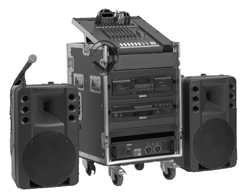On Twitter, @busyscott asked if I knew of any “How To” guides for building a portable sound system.
I thought for a while, and realized I couldn’t think of any. So I thought I’d write up a Reader’s Digest condensed version.
This won’t be comprehensive, but will have a few thoughts on what I consider important for portable system design.
Of course, all these ideas need to be considered in light of your needs, which may be different from mine.
Make It Portable
This may seem obvious, but based on some of the “portable” systems I’ve seen, it seems this rule is oft-ignored.
Mike’s first rule of portability is this: Never carry what you can roll. The second is like it: Never roll what you can get someone else to roll.
Even when people remember this rule, there are a few things that sometimes get missed.
First, use good wheels. And by good, I mean at least 2-inches to 2 1/2-inches in diameter (larger is better).
Second, make sure the wheels (at least some of them) lock. In portable situations, you may find yourself setting up on un-level ground, and locking wheels will keep your portable system from ending up in a pond.
Part of portability means smart packaging. SKB and others make very slick rolling racks with mixer rails in the top, and vertical rack rails below. These make ideal small system building blocks. Drop in a rack-mountable mixer, add necessary outboard gear and you’ve got front of house taken care of.
I’ve been working on a system like this at Coast Hills for a few years. I’ve slowly been re-purposing equipment, and filling out my rack to get us to a place where we can roll it out and be ready to go.
Manage Expectations
This isn’t so much a rule as a reminder as you’re building your system. We sound guys like to overkill everything, all in the name of the best possible sound. That’s a good thing, generally. But in portable systems, we’re typically doing simple events that don’t require concert level sound (and if they do, bring in a concert level PA…).
I find myself using my portable system with an iPod for background music and one or two mics for announcements about 80% of the time. The other 20% consists of off-site retreats and the like where the acoustics are much, much less than ideal and the expectations are similar.
This is a good thing, as we don’t need to spend a small fortune to build a high-end system. We are typically looking for basic sound reinforcement, so a set of powered speakers usually work just fine. If you pair them with a set of powered subs as well, you’re well down the road to decent sound.
In our case, when we installed the EV Live-X system in our student room, I pulled down the old EONs and the subs. Those got re-purposed as my portable speakers. They’re not the best, but they work fine for what I need.





















